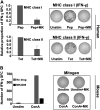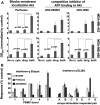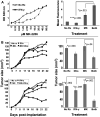Th1 cytokines in conjunction with pharmacological Akt inhibition potentiate apoptosis of breast cancer cells in vitro and suppress tumor growth in vivo
- PMID: 32774769
- PMCID: PMC7392628
- DOI: 10.18632/oncotarget.27556
Th1 cytokines in conjunction with pharmacological Akt inhibition potentiate apoptosis of breast cancer cells in vitro and suppress tumor growth in vivo
Abstract
Targeted drug approaches have been a major focus for developing new anticancer therapies. Although many such agents approved in the last 20 years have improved outcomes, almost all have underperformed expectations. The full potential of such agents may yet be obtained through novel combinations. Previously, we showed that anti-estrogen drugs combined with a dendritic cell-based anti-HER-2 vaccine known to induce strong Th1-polarized immunity dramatically improved clinical response rates in patients with HER-2pos/ERpos early breast cancer. Here, we show that the small molecule Akt antagonist MK-2206, when combined with the Th1 cytokines IFN-gamma and TNF-alpha, maximize indicators of apoptotic cell death in a panel of phenotypically-diverse human breast cancer lines. These findings were mirrored by other, structurally-unrelated Akt-targeting drugs that work through different mechanisms. Interestingly, we found that MK-2206, as well as the other Akt antagonist drugs, also had a tendency to suppress Th1 cytokine expression in stimulated human and murine lymphocytes, potentially complicating their use in conjunction with active immunotherapy. After verifying that MK-2206 plus IFN-gamma could show similar combined effects against breast cancer lines, even in the absence of TNF-alpha, we tested in a rodent HER-2pos breast cancer model either a HER-2-based DC vaccine, or recombinant IFN-gamma with or without MK-2206 administration. We found that for MK-2206, co-administration of recombinant IFN-gamma outperformed co-administration of DC vaccination for slowing tumor growth kinetics. These findings suggest a combined therapy approach for Akt-targeting drugs that incorporates recombinant Interferon-gamma and is potentially translatable to humans.
Keywords: Akt kinase; breast cancer; immunotherapy.
Conflict of interest statement
CONFLICTS OF INTEREST None.
Figures








Similar articles
-
Statin Drugs Plus Th1 Cytokines Potentiate Apoptosis and Ras Delocalization in Human Breast Cancer Lines and Combine with Dendritic Cell-Based Immunotherapy to Suppress Tumor Growth in a Mouse Model of HER-2pos Disease.Vaccines (Basel). 2020 Feb 6;8(1):72. doi: 10.3390/vaccines8010072. Vaccines (Basel). 2020. PMID: 32041347 Free PMC article.
-
PIM kinase inhibitor AZD1208 in conjunction with Th1 cytokines potentiate death of breast cancer cellsin vitrowhile also maximizing suppression of tumor growthin vivo when combined with immunotherapy.Cell Immunol. 2024 Mar-Apr;397-398:104805. doi: 10.1016/j.cellimm.2024.104805. Epub 2024 Jan 8. Cell Immunol. 2024. PMID: 38244265
-
Sunitinib Combined with Th1 Cytokines Potentiates Apoptosis in Human Breast Cancer Cells and Suppresses Tumor Growth in a Murine Model of HER-2pos Breast Cancer.Int J Breast Cancer. 2021 Apr 14;2021:8818393. doi: 10.1155/2021/8818393. eCollection 2021. Int J Breast Cancer. 2021. PMID: 33936816 Free PMC article.
-
Restoring Lost Anti-HER-2 Th1 Immunity in Breast Cancer: A Crucial Role for Th1 Cytokines in Therapy and Prevention.Front Pharmacol. 2016 Oct 6;7:356. doi: 10.3389/fphar.2016.00356. eCollection 2016. Front Pharmacol. 2016. PMID: 27766079 Free PMC article. Review.
-
Molecular immunological approaches to biotherapy of human cancers--a review, hypothesis and implications.Anticancer Res. 2006 Mar-Apr;26(2A):1113-34. Anticancer Res. 2006. PMID: 16619514 Review.
Cited by
-
Intercepting Premalignant, Preinvasive Breast Lesions Through Vaccination.Front Immunol. 2021 Nov 24;12:786286. doi: 10.3389/fimmu.2021.786286. eCollection 2021. Front Immunol. 2021. PMID: 34899753 Free PMC article.
-
Interaction between the breast tumor microenvironment and gut microbiome.Gut Microbes. 2025 Dec;17(1):2514136. doi: 10.1080/19490976.2025.2514136. Epub 2025 Jun 8. Gut Microbes. 2025. PMID: 40484980 Free PMC article. Review.
-
Murine Dendritic Cells Grown in Serum-Free Culture Show Potent Therapeutic Activity when Loaded with Novel Th Epitopes in an Orthotopic Model of HER2pos Breast Cancer.Vaccines (Basel). 2021 Sep 18;9(9):1037. doi: 10.3390/vaccines9091037. Vaccines (Basel). 2021. PMID: 34579275 Free PMC article.
-
Targeting of the tumor immune microenvironment by metformin.J Cell Commun Signal. 2022 Sep;16(3):333-348. doi: 10.1007/s12079-021-00648-w. Epub 2021 Oct 5. J Cell Commun Signal. 2022. PMID: 34611852 Free PMC article. Review.
-
Differentiation and Regulation of TH Cells: A Balancing Act for Cancer Immunotherapy.Front Immunol. 2021 May 3;12:669474. doi: 10.3389/fimmu.2021.669474. eCollection 2021. Front Immunol. 2021. PMID: 34012451 Free PMC article. Review.
References
-
- Oiseth SJM, Aziz S. Cancer Immunotherapy: a brief review of the history, possibilities, and challenges ahead. J Cancer Metastasis Treat. 2017; 3:250–61. 10.20517/2394-4722.2017.41. - DOI
-
- Czerniecki B, Koski G, Koldovsky U, Xu S, Cohen P, Mick R, Nisenbaum H, Pasha T, Xu M, Fox K, Weinstein S, Orel S, Vonderheide R, et al.. Targeting HER-2/neu in early breast cancer development using dendritic cells with staged interleukin-12 burst secretion. Cancer Res. 2007; 67:1842–52. 10.1158/0008-5472.can-06-4038. - DOI - PubMed
-
- Sharma A, Koldovsky U, Xu S, Mick R, Roses R, Fitzpatrick E, Weinstein S, Nisenbaum H, Levine BL, Fox K, Zhang P, Koski G, Czerniecki BJ. HER-2 pulsed dendritic cell vaccine can eliminate HER-2 expression and impact ductal carcinoma in situ . Cancer. 2012; 118:4354–62. 10.1002/cncr.26734. - DOI - PMC - PubMed
LinkOut - more resources
Full Text Sources
Research Materials

